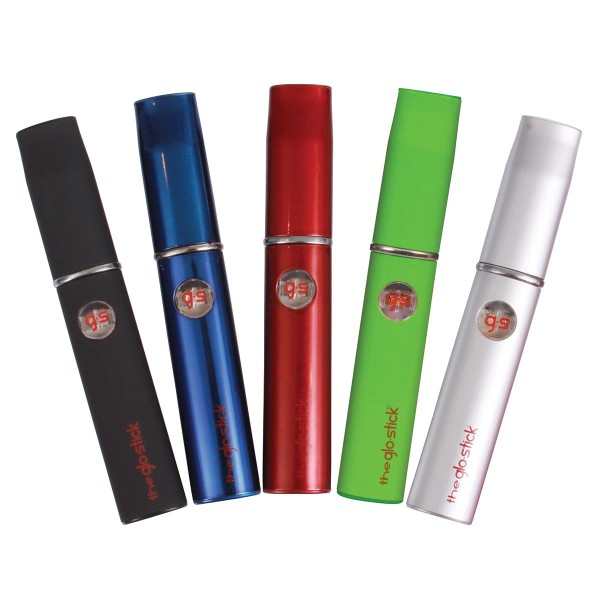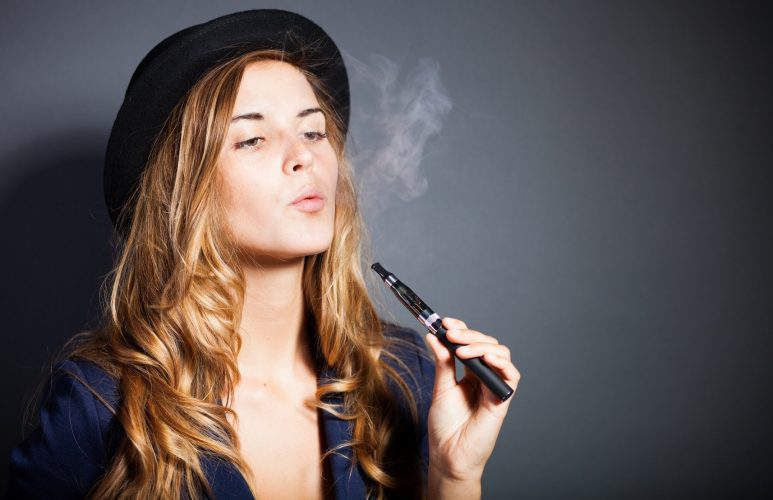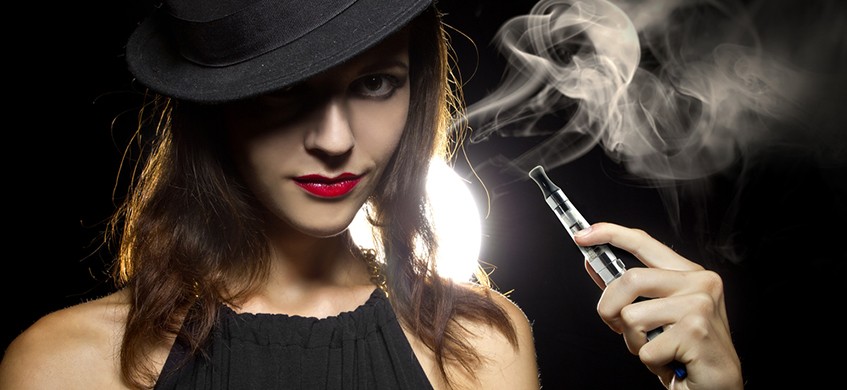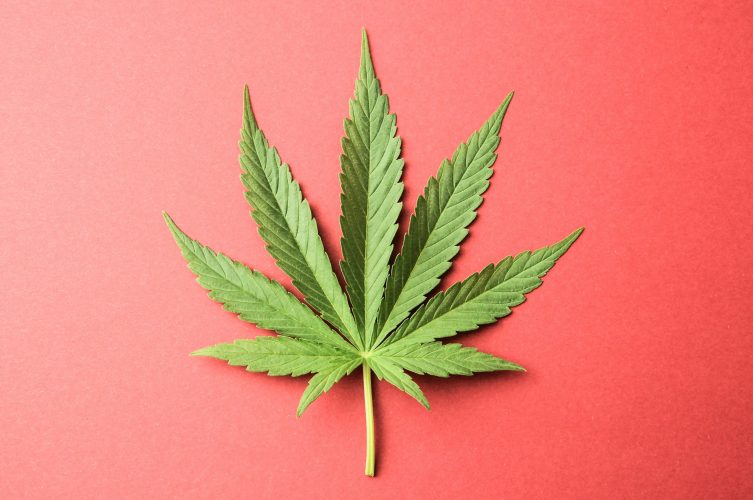The debate on liquid marijuana started at Emmys Awards 2014 when Sarah Silverman’s pot-filled e-cigarette with liquid marijuana, she showed, on the red carpet. One day after the comic showed off her pot-filled e-cigarette on the Emmys red carpet, the future of marijuana moved from the back of a VW microbus to the cutting edge of technology.

Synthetic marijuana has been classified as a Schedule I drug by the U.S. government, but that hasn’t stopped it from resurfacing on the streets in a liquid form. Medical marijuana is currently legal in 14 U.S. states and the District of Columbia. This year more than a dozen state legislatures considered or are considering medical marijuana laws. Medicinal cannabis is legal in Canada, Austria, UK, the Netherlands, Sweden, Spain, Israel and Italy.
It all started in an apparently unscripted moment with E! hostess Giuliana Rancic when Silverman — in a pot colored dress, no less — revealed more than her ample cleavage.
“This is my pot,” she said. “Liquid pot.”
With that the internet exploded. “Live your life girl!” tweeted actress Anna Kendrick to her nearly three million followers.
It’s no surprise that Hollywood partakes of the wacky weed — after all, celebs from Cheech and Chong to Snoop Dogg to the makers of “Weeds” have been high on pot for decades — but Silverman’s choice of delivery system got everyone buzzed.
“Seeing her Monday night was pretty awesome,” says Christian Rado, whose L.A.-based company Vaporous Technologies makes the J-Pen vaporizer that Silverman prefers.
He touted the Jetson’s-like joint because it enables pot users to openly enjoy the popular and increasingly legal recreational drug yet waft very little smoke and almost none of the tell-tale scent of ganja.
With the e-cig, he said, pot lovers don’t have to “slink off somewhere secluded.”
This being Hollywood, he also put in a plug for his liquid gold: “We make a high end product for the connoisseur.”
Vape pens work by heating up and vaporizing a concentrated marijuana oil that is inhaled. The results are the same — go ask a teenager what they are — as smoking, but advocates for e-cigarettes say it is much less harmful on the lungs.
 It’s also a lot more discrete — unless you pull out your vapor pen on national television. Then again, Silverman has a medical marijuana prescription, so she can ride Puff the Magic Dragon anywhere in California except public places.
It’s also a lot more discrete — unless you pull out your vapor pen on national television. Then again, Silverman has a medical marijuana prescription, so she can ride Puff the Magic Dragon anywhere in California except public places.
That means she could have been #HAF — the internet hashtag for, well, being tagged by hash — at the Emmy Awards. Silverman denied it, but when she accepted her award for outstanding writing for a variety special, she offered a monologue straight out of “Dazed and Confused,” mentioning how “we’re just all made of molecules, and we’re hurling through space right now.”
Silverman is not the only celebrity whose pen is mightier than the bong.
Earlier this year, Whoopi Goldberg wrote a column for The Cannabist called “My vape pen and I, a love story.”
“When I show her to a friend, the reaction 99% of the time is: ‘Holy s—, where did you get this and how can I get me one?'” Goldberg wrote.Synthetic marijuana might have been classified as a Schedule I drug by the U.S. government, but that hasn’t stopped it from resurfacing on the streets in a liquid form.
The liquid drug has been found throughout several locations in Hawaii and numerous mainland states. A shop in Honolulu was found to be selling 2 ml bottles of the liquid for up to $50 and marketed it for use in conjunction with electronic cigarettes. Synthetic marijuana manufacturers are known to slightly alter the compounds of the drug as a means of evading police, but such practices have posed serious health concerns because each batch varies in potency as a result.
“The chemists are savvy,” said Hawaii Sen. Josh Greene, chair of the Senate health committee. “They stay a half-step ahead of us and we change the formulary and we put people behind bars. What we really need to do is increase the penalties.”
Earlier this month, a wave of emergency room visits throughout Texas were linked back to a questionable batch of synthetic marijuana. Over 100 overdoses in Dallas and Austin were reported over a five-day period, with patients reportedly hallucinating, suffering seizures, and violently acting out. Parkland Hospital physician Dr. Stacy Hail noted that some patients had “to be restrained” due to their reaction to the drug.
“Several of them came in with similar symptoms of psychosis, altered mental status, abnormal behavior – ranged from very sedated to an agitated state,” said Dr. James E’tienne, an emergency room physician at Baylor University Medical Center. “We don’t know what they’re putting in these synthetic drugs.”
Tincture – Marijuana Extract in Liquid Form
Marijuana tincture is not new but it is definitely newly popular as a result of the increase in marijuana dispensaries that have exploded into our cities. Using marijuana in liquid form opens up the possibilities of being used by a whole new segment of society who would be averse to smoking pot. While it might not be as harmless as many of the other addictive drugs we treat, we are still concerned about the users who will become dependent and graduate to stronger substances like opioids.
Marijuana Tincture: Fact Sheet – What is Marijuana Tincture?
A tincture is traditionally a medicinal solution of an active medicine or herb and an alcohol solvent.
Marijuana tincture is simply cannabis plant material that has been soaked in a strong alcohol and strained. The resulting liquid is then ingested orally or sublingually (under the tongue) as a means of intoxication or to treat the myriad number of disorders that marijuana is currently being prescribed.
Historically, tincture of cannabis was used recreationally and as an herbal remedy alongside other tinctures, like the opiate based Laudanum and the wormwood based Absinthe.
Probably the most common tincture that most of us have seen or used is the stinging Mercurochrome which used to be sold in a small dropper bottle to treat scrapes and scratches or a tincture of Iodine which is found mostly in survival kits for emergency disinfecting of water.
In recent years, the influx in medical marijuana dispensaries has increased the need for a method of marijuana delivery that did not rely on the inhalation of smoke. One of the most popular methods has become marijuana tincture. It is a very small, discreet way for a user to administer marijuana without drawing attention or having to breathe in potential carcinogens.
What does Marijuana Tincture look like?
Marijuana Tincture is a dark green liquid, normally found in small bottles with a dropper attached, or in a pump spray bottle. It smells and tastes strongly of cannabis. Due to the high strength alcohol that is used in the process, the tincture may produce a burning sensation to the tongue.
What are the street names for Marijuana Tincture?
Marijuana tincture is most commonly referred to as simply “tincture”, but is also referred to as:
- tincture of cannabis
- liquid marijuana
- liquid THC
- green dragon
- mayzack
- tink
How is Marijuana Tincture made?
Marijuana tincture is made in two different ways. There is a hot method or a cold method.
The most common and traditional method is the cold method. During this process the cannabis is sealed in a jar filled with a very high proof alcohol. It is then shaken everyday and after a few weeks, the cannabinoids will have been absorbed by the alcohol and the marijuana is then strained out and discarded.
The hot method, or “green dragon” method as it is often referred, is the same basic process of using alcohol to absorb the cannabinoids. The main difference is the application of heat, normally on a stove top. Although the risk of ruining the drug and potential fire hazard of heating alcohol over flame keeps many from attempting this method, the process is much quicker (the total time is reduced to a couple hours rather than a couple weeks), and therefore it is gaining in popularity.
How is Marijuana Tincture used?

Marijuana Tincture is most commonly administered orally via a medicine dropper or pump spray. A normal dosage is around 2-3 drops or 1-2 sprays with an intoxication period of 2-4 hours, possibly longer depending on the strength of the solution. The solution is often mixed with another liquid or added to food.
A second method of delivery for the tincture is as a compress on a sore joint or muscle. Often for the alleviation of pain due to arthritis, this method will also have the side effect of staining the user’s skin the green color of the liquid.
What are Marijuana Tincture’s effects?
The effects of a marijuana tincture are the same as smoked marijuana: euphoria, confusion, slowed thinking and reaction time, impaired balance and coordination.
What are Marijuana Tincture’s dangers?
Like all cannabis related drugs, the short-term effects of tincture use include problems with:
- perception
- difficulty in thinking and problem solving
- lowered inhibitions
- memory
- learning difficulties
- a lack of motivation
- a loss of coordination
Many people also experience and increased heart rate, anxiety, and panic attacks.
The long-term effects may include possible cannabis addiction. Although cannabis hasn’t been proven to be physically addictive, it can be mentally addicting and abused like any other drug. Not every person will become addicted, but some will show signs of mental addiction, including a continued use of tincture and other edible marijuana products even though the effects are having a negative effect on their lives and the lives of the people around them.
Treatment for Marijuana Addiction
Our treatment centers have many years experience treating marijuana addiction. Abuse of these substances often lead to abusing harder drugs like cocaine or heroin. If you are concerned about someone using marijuana please call our treatment centers at 866-323-5609.
BRITAIN APPROVES LIQUID MARIJUANA AS PRESCRIPTION MEDICINE
It was announced today that Sativex, a cannabinoid-based liquid medicine sprayed under the tongue, has been approved for use in Great Britain to help treat the muscle spasticity suffered by multiple sclerosis patients. Sativex is a natural marijuana extract that is produced by British-based GW Pharmaceuticals. It has been approved for use in Canada to treat neuropathic pain since 2005.
“Once again, the scientific community has confirmed that marijuana is medicine and it can provide safe and effective relief to patients suffering from certain conditions,” said Rob Kampia, executive director of the Marijuana Policy Project. “Sadly, our federal government, through the Drug Enforcement Administration, has blocked effective research into the therapeutic effectiveness of marijuana. The United States could be leading the world in the development of cannabinoid-based medicines, but instead our government has ceded this industry to the U.K., while intentionally prolonging the agony of patients in this country.”
The Food and Drug Administration has already approved the pill Marinol, which contains marijuana’s main psychoactive component, THC, for medical use in the United States, but unlike Sativex, Marinol does not contain all of marijuana’s more than 60 different cannabinoids, and therefore doesn’t offer the full therapeutic potential of marijuana. Among patients, Marinol is notoriously ineffective.
“The good news is that this announcement buttresses our argument that marijuana is an effective medicine. To have liquid marijuana legal for medical use but marijuana illegal would be like having coffee legal but coffee beans illegal,” Kampia added.
Medical marijuana is currently legal in 14 U.S. states and the District of Columbia. This year more than a dozen state legislatures considered or are considering medical marijuana laws.
PREMIER Denis Napthine says he supports the decision of the medical administration not to legalise medicinal marijuana, even after it has been revealed it saved a young girl’s life.
Victorian mum Cheri O’Connell spoke out about the benefits of liquid marijuana, which she says saved her epileptic daughter who was only given months to live.
“These issues in terms of approving medications are issues for the Therapeutic Goods Administration under the Federal Government,” Dr Napthine said.
“They base their decisions on the best medical advice and science. That’s the way these decisions ought to be based and I support that process.”
Eight-year-old Tara was having up to 60 seizures a day but has made a miraculous recovery since her mother , Cheri started giving her liquid cannabis made in Nimbin.
Doctors at one of Victoria’s leading hospitals have acknowledged the “remarkable improvements” in the girl’s condition one year after she started taking the drug.
But Health Minister David Davis has warned families not to use medicinal marijuana, saying it remains illegal in Victoria and that the Government “does not intend to change this legislation”.
A Sunday Herald Sun investigation has found that up to 10 Victorian children, some as young as three, are taking daily doses of medicinal marijuana – in some cases administered by teachers – as desperate parents turn their back on pharmaceutical drugs.
Cheri O’Connell gives her daughter Tara a liquid form of medicinal marijuana known as THC-A – which is posted to her in the mail – to treat her severe epilepsy.
Ms O’Connell’s claims of her daughter’s miracle recovery – backed by Victoria’s peak medical body – have fuelled calls for local clinical trials to test the effectiveness of medicinal marijuana.
“She was dying, she could barely walk or talk, was unable to toilet herself and slept a similar cycle to a newborn,” Ms O’Connell said.
“We had basically been told that there was not too much more we could do, just to take her home and to love her and maybe if you are lucky she’ll get to nine.
“We didn’t see her having a future at all,” Ms O’Connell said.
“Now, well she is never going to be the kid that holds a job and goes off and does everything because it’s too late, the damage has been done.”
Tara required a wheelchair, struggled to walk and had limited speech.
But in January last year, her desperate parents started her on a cannabis mix known as a tincture, after a cocktail of prescribed medications left her heavily sedated and failed to stop the seizures.
In developments that have surprised doctors, one year on, Tara is a bubbly eight-year-old and her wheelchair is collecting dust in the corner of the family’s home in central Victoria.
A recent neuropsychological assessment report by a leading doctor at Austin Health said Tara’s overall cognitive performances were “significantly improved on those documented 12 months ago.”
“Since commencing medical cannabis (together with the cessation of her seizures), there is a convincing clinical history of improvements in all facets of her presentation as reported by her mother,” senior clinical neuropsychologist Dr Silvana Micallef wrote.
An increased appetite and fatigue were the only recorded side-effects.
The medical-grade marijuana, is administered orally through drops under the tongue and manufactured to be low in THC, the compound that produces a “high.”
The O’Connells have also started son Sean, 11 – who has a less severe form of epilepsy – on liquid cannabis. Ms O’Connell said her son could barely write before the drug, now he is seizure free and is a budding artist.
She is calling on the state government to fund research into the drug which she claims has saved her daughter’s life and is being used by at least 70 children across Australia.
The Sunday Herald Sun understands the liquid cannabis is administered to a number of Victorian students by school staff.
A spokesman from the Department of Education, Stuart Teather, refused to comment on any specific case citing student privacy.
Victoria’s peak medical body has backed the call for further research into medicinal cannabis.
AMA Victoria vice-president Dr Tony Bartone said cannabis was being used legally for medical purposes in places such as Canada, the USA, the UK and Germany.
“There is a growing body of evidence on cannabis as an effective treatment for some types of chronic pain, the control of muscle spasticity, some forms of nausea and as an appetite-stimulant in patients with weight loss due to cancer or HIV,” Dr Bartone said.
He said the AMA supported more research, particularly into the administration of medicinal cannabis, “as smoking or ingesting a crude plant product is harmful.”
Epilepsy Australia general manager of Client Services, Wayne Pfeiffer also backed a call for “an effective and controlled trial”.
“Some families have asked about it, but as it is illegal we can’t really recommend it but there is a growing interest,” Mr Pfeiffer said.
“About 70 per cent of people get control of seizures through medications, so for these remaining 30 per cent of people they are really hopeful of any new drugs.”
Kay McNeice, spokeswoman for the federal Health Department, said: “T he manufacture, possession, sale or use of any form of cannabis is prohibited under state and territory drugs and poisons legislation.
“These controls are in place for public health and safety to ensure, that all care is taken to prevent misuse of substances which are deemed harmful and for which there is no approved medicinal use.”
We had to break the law or see her die ANY parent will do whatever it takes to make a sick child better.
For the O’Connell family, that meant breaking the law – or losing their daughter.
And after years of visiting doctors, using conventional medication and suffering heartbreak, the O’Connells say one of the last options left was the controversial use of medicinal cannabis to try to give Tara any future.
The eight-year-old suffers from a severe form of epilepsy known as Dravet syndrome, and had been seriously ill all her life.

Paramedics had even warned her parents they might not be able to resuscitate Tara next time, after four close calls.
Tara could barely walk or talk and she slept as much as a newborn. She endured more than 20,000 seizures every year, and it was taking its toll on her tiny body.
Her condition left Cheri and partner David, and Tara’s siblings Sean and Jasmine, exhausted and fearing for the future.
Running out of options, by chance, another family who had lost a similar battle told the O’Connells about medicinal cannabis.
“They didn’t get to try the drug,” Cheri said.
“She knew we didn’t have long to go with Tara, we had nothing to lose. The side-effect of not giving it to her was death. We have now passed the 12-month mark and she’s healthier than ever.”
Cheri said they knew the legal risks around the drug. ”We just thought, ‘What else do they want us to do?’ It’s that or our kid dies,” she said.
One year on, Tara is now seizure-free, walking, running and even dancing.
“We didn’t see her having a future at all,” Cheri said.
“Now, well she is never going to be the kid that holds a job and goes off and does everything because it’s too late, the damage has been done.
“But I can now see us being able to put a unit here and being able to live semi-independently. Before, that was never going to happen.”
Across Australia a secret network of parents is using social media to share their experiences of medicinal cannabis for their sick kids.
One mum, from Mernda in Melbourne’s outer north, said her three-year-old son had shown dramatic improvements since taking it.
Her son had meningitis as a baby and is intellectually and physically disabled.
“We were told he’d be lucky to make it to two years old,” she said.
“We hesitated for 18 months. But after his first dose, within 15 minutes he was tracking things with his eyes for the first time.”
She said the law needed to be changed so parents could legally access the drug.
“We are anti-drugs,” she said. “We feel like we are breaking the law, but if we didn’t do it when we did, we wouldn’t have him now.”
In South Australia, a mother-of-two said her eight-year-old daughter was taking eight pharmaceutical medications before the family sourced the medicinal marijuana from interstate.
“I got to the point where we had nothing to lose. She was seizure-free within a day, where she would previously have two to three a day,” the woman said.
Medicinal cannabis is legal in Canada, Austria, the Netherlands, Sweden, Spain, Israel, Italy and in some states of the US.
Officials: Liquid synthetic pot new drug threat
The Georgia Bureau of Investigation and Dalton police said they have seized a new and dangerous form of synthetic marijuana that is designed to be consumed using vapor pens.
During a raid of a tobacco shop and another location in Dalton this week, investigators seized over 30 pounds of synthetic marijuana with an estimated street value of $150,000.
The seizure included small bottles containing a liquid form of synthetic cannabinoid, a packaging of the drug that they had not previously seen.
“This is cutting edge stuff. This is another thing to be on the lookout for,” said Dalton police spokesman Bruce Frazier.
The product seized, “Cloud Nine,” is sold as incense. But police said it is designed to be consumed in vaporizing pens, which make a near odorless vapor.
“If you were a parent or an employer, you wouldn’t know someone is smoking this stuff,” Frazier said.
Police said they believe the drug is being sold under the counter in other locations across the state, including the metro Atlanta area.
“This stuff can be a lot more potent, because you put more of it, too much, and get a significant dose through a vapor pen,” Frazier said.
Channel 2’s Tom Regan spoke with local parents about the new liquid drug and the risk to young people.
“For them to be able to do it, undetected and probably in plain sight of their parents is the scariest part,” said parent Leslie Simmons.
Dalton police arrested the store owner on drug charges and expect to make additional arrests.
WHAT IS SATIVEX?
Sativex is a natural marijuana extract developed by a British company, GW Pharmaceuticals. It is a liquid that is sprayed into the mouth. Made from marijuana plants bred for specific levels of various active components, called cannabinoids, Sativex is similar to marijuana-based extracts and tinctures that were legally available in the United States until 1937. (Such products were manufactured by major drug companies and sold through pharmacies until the federal government banned marijuana in 1937.)
IS SATIVEX LIKE MARINOL®, THE PRESCRIPTION THC PILL?
No. Marinol contains only a synthetic version of THC, which is just one of marijuana’s approximately 60 active components, called cannabinoids. Sativex contains THC and other cannabinoids, as well as other compounds contained in the marijuana plant, which scientists believe contribute to marijuana’s therapeutic benefits.
SO SATIVEX IS A LOT LIKE NATURAL MARIJUANA?

Yes. Sativex is, for all practical purposes, liquid medical marijuana. In essence, Sativex is to marijuana as a cup of coffee is to coffee beans.
IS IT TRUE THAT, UNLIKE MARIJUANA, SATIVEX DOESN’T PRODUCE A “HIGH”?
Sativex and marijuana are nearly identical in this regard: Most medical marijuana users obtain relief without becoming intoxicated, and the same is true of Sativex. While both contain THC, the component that produces marijuana’s “high,” both also contain other natural plant components which moderate its effects, and both allow users to adjust their dose as needed to obtain relief without intoxication.
WHAT CONDITIONS HAS SATIVEX BEEN TESTED FOR?
Most testing thus far has been done on patients suffering from multiple sclerosis and various types of chronic pain, including cancer pain. These studies have shown Sativex to have strong benefits and mild side effects, and patients do not develop a tolerance to it (meaning they do not have to increase the dosage to continue receiving the same therapeutic benefi ts). Further tests are planned for other conditions, but Sativex research has already provided definitive proof of marijuana’s medical safety and efficacyconfirming that virtually everything the U.S. government has told us about marijuana is wrong.
IS SATIVEX LICENSED FOR PRESCRIPTION SALE ANYWHERE?
The Canadian government approved the prescription sale of Sativex on April 19, 2005. An application is also pending in Great Britain, which could be granted by the end of 2005.
WHY WASN’T SATIVEX DEVELOPED IN THE U.S.?
The federal government has done everything in its power to prevent effective research on the therapeutic benefits of marijuana from proceeding in the United States. For example, in December 2004, after a three-and-a-half-year delay, the U.S. Drug Enforcement Administration turned down a proposal by the University of Massachusetts to establish a facility to manufacture marijuana. Such a facility would be needed in order for a company located in this country to develop a product like Sativex, made from specially-developed strains of natural marijuana.
WILL AMERICANS BE ABLE TO PURCHASE SATIVEX IN CANADA AND BRING IT INTO THE U.S.?
No. Because marijuana is classified as a Schedule I drug under federal law, doing so would be a felony. Indeed, importing less than 50 kilograms of marijuanaeven a small amount of marijuana for medical useis punishable by up to five years in federal prison.
WILL SATIVEX BE AVAILABLE IN U.S PHARMACIES?
Not in the foreseeable future. U.S. testing hasn’t begun, and the federal government has given no indication that it will even allow such testing to proceed. Because of this, approval by the FDA is most likely years away and may never occur.
WILL SATIVEX ELIMINATE THE NEED FOR MEDICAL MARIJUANA?
No. Sativex acts far more slowly than marijuana that is inhaled (as through a vaporizer). According to the company’s official product information, peak blood levels aren’t reached for more than an hour and a half — about as slowly as Marinol, which many doctors and patients consider unacceptably slow. Sativex is also expensive — about $3 Canadian per spray, or about $15 per day at the average dose. In addition, patients have found that different strains of marijuana provide the best relief for different conditions, so Sativex is unlikely to benefit every patient who currently benefits (or could benefit) from whole marijuana. Sativex is simply another form of medical marijuana, and patients and doctors should be able to choose what works best for each patient’s particular situation. If, after years of research, the FDA were to approve Sativex as a prescription medicine in the U.S., arresting and jailing patients for using herbal marijuana would make no more sense than allowing people to drink coffee while jailing them for possessing coffee beans.
Liquid Marijuana Approved in Canada
Canada has approved the use of Sativex, a liquid form of marijuana that is sprayed inside the mouth. It has been found to be an effective pain reliever for those suffering from multiple sclerosis.
Videos
https://youtube.com/watch?v=WYx9LzQqGio
Disclaimer
The Content is not intended to be a substitute for professional medical advice, diagnosis, or treatment. Always seek the advice of your physician or other qualified health provider with any questions you may have regarding a medical condition.